Everything 10%-40% off. Ends Wednesday.
Michael Hagedorn Interview: Part 2
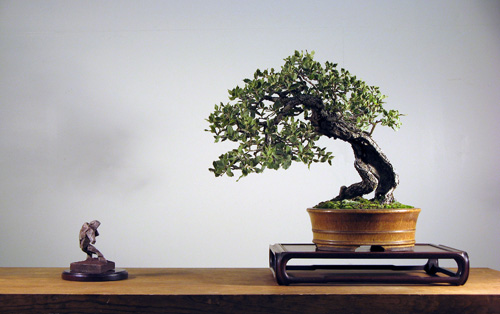
This is the second and final installment of our Michael Hagedorn interview.
Do you collect wild trees? Any advice if you do?
I do collect. And I would definitely advise studying the techniques of taking wild trees with a very experienced collector who has a high success rate. Studying this seriously is better than learning by mistake and experiment—enough have done that already!
The tree pictured above is Sonoran scrub live oak (Quercus turbinella). Michael says of this tree: I collected this oak from a mountain range in eastern Arizona in 1999, at around 5,000 ft. It was growing much like old pines or junipers along rocky breaks, in a ‘captive root’ situation. There were fine roots in a pocket of soil on bedrock. I cut the anchor root, lifted the tree, and it went into a small box. The oak from the start was very vigorous, and one or two years later was in a bonsai pot. The photo is from 2008, prior to its trip to the National Bonsai Show. Accent is a small sculpture that I made in college. The container is from my past life as a potter. To see more of Michael’s trees, visit Crataegus Bonsai.
Michael Hagedorn Interview: Part 1

In my last post I wrote a review of Michael Hagedorn’s Post-Dated; The Schooling of an Irreverant Bonsai Monk, a book I consider to be an important and unique contribution to English language bonsai literature. You could say that Post-Dated is in fact literature, as distinguished from the how-to genre that most bonsai books fall into.
In addition to being a very accomplished writer, Michael Hagedorn is a first rate bonsai artist. His work appeared in the Kokufu show in Tokyo (Kokufu is the pre-eminent bonsai show in Japan) in 2004, 2005 and 2006, and Mr. Suzuki (Michael’s teacher) honored him with the opportunity to wire two trees that went on to win a Kokufu Prize and a Prime Minister Award.
This interview is in two installments. Stay posted for part 2.
Why Post-Dated?
Post-Dated is a title that the reader will only understand on finishing the book. The last chapter gives a clue to it’s choice.
What do you think is the most important thing you learned in Japan?
I came to believe that bonsai was unlike any of the other creative expressions I’d explored before. It was not modern art. It was not individualistic. It assumed collaboration: by default, with other artists, through time. It was collaboration with a living thing. It was collaboration with a tradition. This was all new to me and, honestly, disorienting. But I came to love it and find a lot of excitement and joy in being a part of that larger surround. I guess anything where we feel part of something larger is a valuable thing, and studying bonsai in Japan was that for me. And I think all bonsai activity has that potential. There, here, anywhere.
Take a Tour of the National Bonsai & Penjing Museum
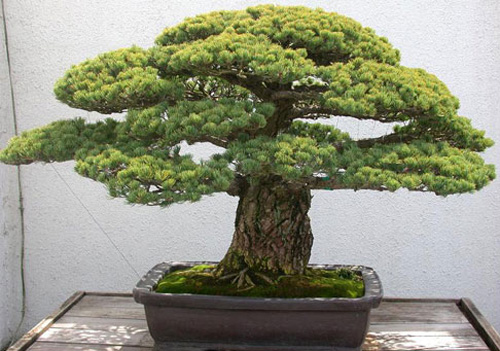 This famous old Japanese white pine is one of the most powerful bonsai anywhere. You can find it at the National Bonsai & Penjing Museum. As always. the photo, though enticing, doesn’t begin to do justice.
This famous old Japanese white pine is one of the most powerful bonsai anywhere. You can find it at the National Bonsai & Penjing Museum. As always. the photo, though enticing, doesn’t begin to do justice.
Next time you are in Washington DC, don’t miss the opportunity to visit our wonderful National Bonsai & Penjing Museum. Meanwhile, you can enjoy some of the bonsai, suiseki and other national treasures right where you are just by clicking bonsai tour.
Continue reading Take a Tour of the National Bonsai & Penjing Museum
Post-Dated by Michael Hagedorn
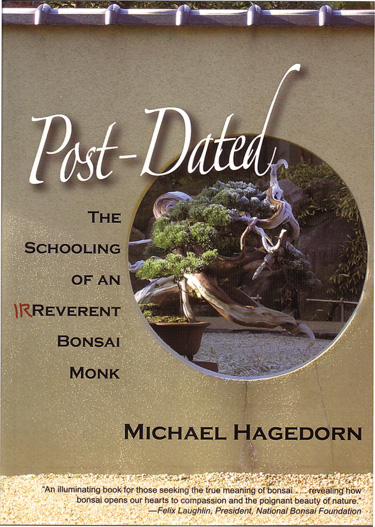
I first read Post-Dated at 30,000 feet; Boston to SFO. By coincidence, the man sitting next to me was reading Thoreau’s Walden, a book usually confined to students and scholars (and everyone else’s bookshelves). He was well past his student years and turned out to be an engineer who simply loved Thoreau.
I bring this up because Post-Dated has a chapter titled: Restless Spirits: The Usefulness of Henry and Ernest. Henry is, of course, Henry Thoreau. Ernest is Ernest Hemmingway. Michael included them in his book because they both studied bonsai in Japan as young men. Henry was gifted, but Ernest was too impatient to get very far with bonsai, though his reputation as a person who could consume rivers of sake, while telling spell binding stories of bullfights, lost lovers and big fish, is still alive and well in Japan (now, after apologizing to our readers (both of you) and especially to Michael Hagedorn, let’s see if we can refocus).
Field Growing 3: Spreading Roots & More
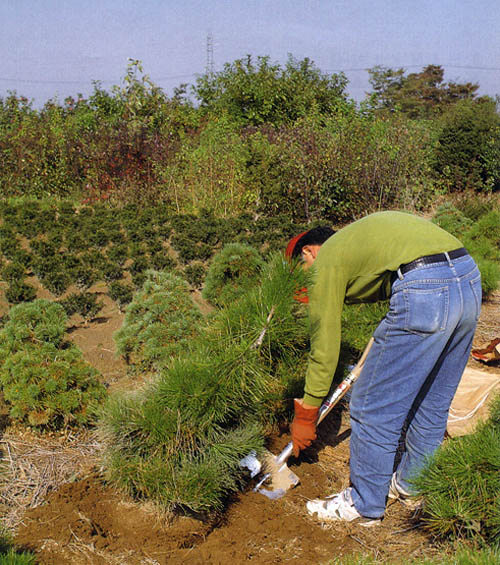
Digging a field grown Japanese Black Pine. From Bonsai Today, issue 75.
In Field Growing 2 I said I just dug a hole and planted. Actually, that isn’t the whole story; when you field grow bonsai stock, you need to cut off the downward growing roots and spread the lateral roots. This encourages lateral top growth (above ground growth) and nebari development (check the top photo in Field Growing 2).
Some people put a board, or tile, or some other flat object a few inches under the roots to inhibit downward root growth and encourage lateral growth. Others, like me, just dig their plants up every couple years and prune and spread the roots each time.
Stone Lantern Tool & Magazine Sale
Chinese Bonsai Tools

Five piece carving set. Made in China.
For years we’ve resisted importing Chinese tools. Japanese tools were absolutely superior and more-or-less affordable, and Chinese tools, though very affordable, were mostly inferior.
Now, all that is changing. Robert Steven (accomplished bonsai artist, author of Vision of My Soul and major player in the Asian and world bonsai communities), has founded a line of Chinese tools that are quite good. And, compared to the ever increasing prices of Japanese tools, a very good investment; at least for those of us with tight budgets.
Energy Balancing
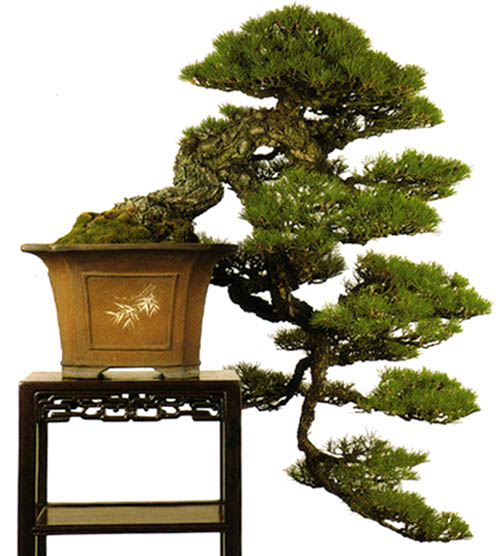
This powerful old cascading Japanese Black Pine (Pinus thunbergii) is a masterful example of how energy can be directed downward in a tree that naturally wants to grow upward. The photo is from Bonsai Today Master Series; Pines.
Whenever you prune, trim or pinch, you are redirecting energy.
If you remove a branch the energy (primarily water, gases and nutrients) that would have flown into that branch goes somewhere else. Some of it goes to forming a callous where the branch was, the rest goes elsewhere.
Basically energy flows two ways in plants; up from the roots, and back down from the leaves. For bonsai, it’s the up from the roots that we are primarily interested in.
Field Growing 2: Native soil
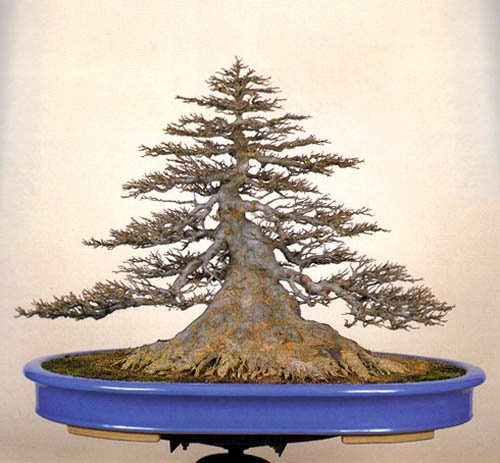 This impressive Trident maple’s (Acer buergeranum) massive nebari is a dead giveaway that it was field grown. The original article is in Bonsai Today issue 64.
This impressive Trident maple’s (Acer buergeranum) massive nebari is a dead giveaway that it was field grown. The original article is in Bonsai Today issue 64.
I once read a report from Cornell University (I can’t find it; anybody?) about the advantages of planting trees directly into the native soil, rather than the common practice of digging in soil amendments, a practice that may be good for the garden center’s bottom line, but not so good for your plants.
If you think about it, it makes sense; if you create a pocket of richer soil, then the roots tend to stay in that pocket. In the not-so-long-run, this causes slower growth and increased susceptibility to drought and winter kill (this may be more relevant to landscape planting than to field growing bonsai, but in my case it works for both).